Afghan afghani
The afghani (sign: Afs[1] or AFs;[2] code: AFN; Pashto: افغانۍ; Dari: افغانی) is the currency of the Islamic Republic of Afghanistan, which is issued by the nation's central bank called Da Afghanistan Bank. It is nominally subdivided into 100 puls (پول), although there are no pul coins currently in circulation. In 2019, one U.S. dollar was exchanged for approximately 75 afghanis.[2]
| Afghan afghani | |
|---|---|
| افغانۍ (Pashto); افغانی (Persian) | |
1 Af, 2, 5, 10, 20, 50, and 100 Afs banknotes | |
| ISO 4217 | |
| Code | AFN |
| Denominations | |
| Subunit | |
| 1⁄100 | pul |
| Symbol | ؋ (U+060B) or Af (sing.) or Afs[1] |
| Banknotes | 1 Af, 2, 5, 10, 20, 50, 100, 500, 1000 Afs |
| Coins | 1 Af,[1] 2, 5 Afs |
| Demographics | |
| User(s) | |
| Issuance | |
| Central bank | Da Afghanistan Bank |
| Website | www |
| Valuation | |
| Inflation | 5% (2018 est.) |
| Source | Da Afghanistan Bank The World Factbook |
History
1925–2002
The original afghani (ISO 4217 code: AFA) was introduced in 1925, replacing the Afghan rupee that was used from 1891 and other currencies.[3] In addition to being subdivided into 100 puls, 20 afghanis were equal to one amani. The rate of conversion from the rupee is sometimes quoted as 1 afghani = 1 rupee 6 paisas,[4] based on the silver contents of the last rupee coins and the first afghani coins. The afghani initially contained 9 grams of silver.[5]
Except during World War I Afghanistan's foreign exchange rate has been freely determined by market forces.[6] However, for some periods, a dual exchange rate regime existed in Afghanistan: an official exchange rate which was fixed by the Afghan Central Bank, and a free market exchange rate which was determined by the supply and demand forces in Kabul's money bazaar called Saraye Shahzada.[7] For example, in order to avoid the seasonal fluctuations in the exchange rate, a fixed exchange rate was adopted in 1935 by the Bank-e-Millie (National Bank), which was then responsible for the country's exchange rate system and official reserves.[7] Bank-e Milli agreed to exchange afghani at 4 Afs against 1 Indian rupee in 1935. After the establishment of Da Afghanistan Bank as the Central Bank of Afghanistan, such a preferential official fixed exchange rate continued to be practiced. Although Da Afghanistan Bank tried to keep its official rate close to the Sarai Shahzada exchange rate, the gap between the official and free-market exchange rates widened in the 1980s and during the civil war thereafter.
The afghani traded at 67 Afs to one U.S. dollar in 1973. After the start of a civil war in 1992, the same U.S. dollar bought 16,000 Afs.[8] Banknotes from the period of Zahir Shah's monarchy ceased to be legal tender by 1991. After the creation of a dysfunctional government and the start of the civil war, different warlords and factions, foreign powers and forgers each made their own afghani banknotes to support themselves financially, with no regard to standardization or honoring serial numbers.
In December 1996, shortly after the Taliban took control of Afghanistan's institutions, Ehsanullah Ehsan, the chairman of the Taliban's Central Bank, declared most afghani notes in circulation to be worthless (approximately 100 trillion Afghani) and cancelled the contract with the Russian firm that had been printing the currency since 1992. Ehsan accused the firm of sending new shipments of afghani notes to ousted president Burhanuddin Rabbani in northern Takhar province. The exchange rate at the time of Ehsan's announcement was 21,000 afghanis to one U.S. dollar. It was then devalued to 43,000 afghanis to the dollar. Abdul Rashid Dostum, who controlled a self-declared autonomous region in northern Afghanistan until 1998, also printed his own money for his region.
Following the United States intervention, the currency became highly destabilized. The afghani traded at 73,000 Afs per one U.S. dollar in September 2001, steeply soaring to 23,000 Afs after the fall of the Taliban regime in November 2001, before plunging again to 36,000 Afs in January 2002.[9] Around seven different versions of the currency were in circulation by that time. A former governor said at the time that maybe "trillions" of banknotes are in circulation as a result.[10]
Since 2002
In 2002, the afghani was denominated, and it received new ISO 4217 code AFN. No subdivisions were issued. It replaced the previous afghani at two distinct rates - issues of the government of former President Rabbani (de jure 1992-2001) were replaced at a rate of 1,000 to the new afghani, whilst the issues of warlord Dostum (1992–1997 in northern Afghanistan) were replaced at a rate of 2,000 to the new afghani. It was created in an effort to stabilize the economy and stop the rapid inflation. The notes were printed in Germany.[11]
The new currency was announced by President Hamid Karzai on September 4, 2002, and was introduced to the market on October 8, 2002.[12] This monetary reform was well received by the public as it was a sign of security and stability, especially the country's rebuilding effort. People also no longer had to carry many bags of money for ordinary things. It was the first time in many years that a sole currency was under the control of the central bank instead of warlords.[8] Most old banknotes were destroyed by the end of 2002.
Da Afghanistan Bank has adopted a floating exchange rate regime and has let the exchange rate to be determined freely by market forces. The new afghani was valued at 43 afghanis to one U.S. dollar.
After depreciating during the last quarter of 2003/04, the afghani has been appreciating steadily, gaining 8 percent against the U.S. dollar between March 2004 and July 2004. This appreciation, at a time of increasing inflation, appears to reflect a greater willingness by the population to use the afghani as a medium of exchange and as a store of value. This trend appears to be attributable to the relative stability of the exchange rate since the introduction of the new currency, administrative measures aimed at promoting its use, such as the requirement that shopkeepers must price goods in afghani. Donors are increasingly making payments in afghanis instead of U.S. dollars and this appears to be widely accepted. By 2009, the afghani was valued at 45 afs per one U.S. dollar. In 2019, the afghani reached 75 afs to a U.S. dollar.[2]
Coinage
In 1925, bronze and brass 2, 5 and 10 pul, billon 20 pul, silver 1⁄2 and 1 afghani, and gold 1⁄2 and 1 amani coins were introduced, followed by silver 2 1⁄2 afghani and gold 2 1⁄2 amani in 1926. In 1930, bronze and brass 1 and 25 pul were added, along with bronze 3 pul and cupro-nickel 10 and 20 pul in 1937.
In 1952, aluminium 25 pul and nickel-clad steel 50 pul were introduced, followed by aluminium 2 and 5 afghani in 1958. In 1961 nickel-clad steel 1, 2 and 5 afghani were minted; the 1 and 2 afghani coins show years of SH 1340 and the 5 Afghani coin shows the year AH 1381.[13] In 1973, the new Republic of Afghanistan issued brass-clad-steel 25 pul, copper-clad steel 50 pul and cupro-nickel-clad steel 5 afghani coins. These were followed, between 1978 and 1980, by issues of the Democratic Republic of Afghanistan consisting of aluminium-bronze 25 and 50 pul and cupro-nickel 1, 2 and 5 afghani. A number of commemorative coins were also issued by the Islamic State of Afghanistan between 1995 and 2001.
On 11 April 2005, coins were introduced in denominations of 1, 2 and 5 afghanis.[14]
| Coins of the Afghani | ||||||||||||
|---|---|---|---|---|---|---|---|---|---|---|---|---|
| Observe | Reserve | Value | Technical parameters | Description | ||||||||
| Diameter | Mass | Composition | Edge | Obverse | Reverse | |||||||
 |
 |
1 Afghani | 20 mm | 3.25 g | Copper-plated steel | Smooth | Coat of arms of Afghanistan | Denomination and year | ||||
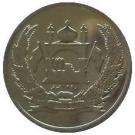 |
 |
2 Afghanis | 22 mm | 4.1 g | Stainless Steel | |||||||
 |
 |
5 Afghanis | 24.2 mm | 5.08 g | Brass | Reeded | ||||||
Banknotes

Between 1925 and 1928, Treasury notes were introduced in denominations of 5, 10 and 50 afghanis. In 1936, 2, 20 and 100 afghani notes were added. The Bank of Afghanistan (Da Afghanistan Bank) took over paper money production in 1939, issuing notes for 2, 5, 10, 20, 50, 100, 500 and 1000 afghanis. The 2 and 5 afghani notes were replaced by coins in 1958. In 1993, 5000 and 10,000 afghani notes were introduced.
.jpg) 20 afghanis banknote during the monarchy, front (1963)
20 afghanis banknote during the monarchy, front (1963).jpg) 20 afghanis banknote during the monarchy, back (1963)
20 afghanis banknote during the monarchy, back (1963).jpg) 100 afghanis banknote during the monarchy, front (1963)
100 afghanis banknote during the monarchy, front (1963).jpg) 100 afghanis banknote during the monarchy, back (1963)
100 afghanis banknote during the monarchy, back (1963)
"A 'pothole cave' or 'mouth of a shaft' (or Pit cave) is said to be visible on the 10,000 afghanis banknote from 1993 as a limited dark area in the hillside above the ancient 'pol' or gateway at the ruins near Lashkar Gah. This is possibly the entrance to one of the man-made undergrounds at Qal'a-i-Bost."[15]
| 1978 Series | ||||||
|---|---|---|---|---|---|---|
| Image | Value | Dimensions | Main Color | Description | ||
| Obverse | Reverse | Obverse | Reverse | |||
 |
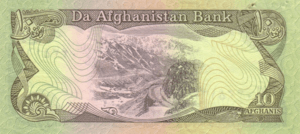 |
10 afghanis | 115 × 52 mm | Green | Seal of Da Afghanistan Bank | Salang Pass |
 |
 |
20 afghanis | 125 × 56 mm | Orange | Seal of Da Afghanistan Bank | Band-e Amir park |
 |
 |
50 afghanis | 134 × 58 mm | Turquoise | Seal of Da Afghanistan Bank | Darul Aman Palace |
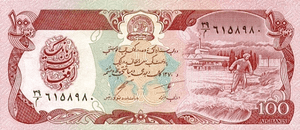 |
 |
100 afghanis | 142 × 62 mm | Pink | Seal of Da Afghanistan Bank, peasant | Dam, hydroelectric power station |
 |
 |
500 afghanis | 151 × 66 mm | Purple | Seal of Da Afghanistan Bank, Buzkashi players | Bala Hissar fortress |
_%D1%84.jpg) |
1.jpg) |
Orange and green | ||||
 |
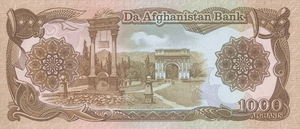 |
1000 afghanis | 160 × 70 mm | Brown | Seal of Da Afghanistan Bank, Shrine of Ali mosque | Paghman Gardens and triumphal arch |
 |
 |
5000 afghanis | 165 × 74 mm | Purple | Seal of Da Afghanistan Bank, Pul-e Khishti Mosque | Tomb of Ahmad Shah Durrani |
 |
 |
10,000 afghanis | 170 × 77 mm | Turquoise | Seal of Da Afghanistan Bank, Great Mosque of Herat | Qal'a-i-Bost fortress of Lashkar Gah |
On 7 October 2002, banknotes were introduced in denominations of 1, 2, 5, 10, 20, 50, 100, 500, and 1000 afghanis. The 1, 2 and 5 afghani notes were replaced by coins in 2005. In 2004 and 2008, the security features on several denominations were improved. In 2014 a new 1000 afghanis note was introduced to prevent counterfeit notes.
| 2002 Series | |||||||
|---|---|---|---|---|---|---|---|
| Image | Value | Dimensions | Main Color | Description | |||
| Obverse | Reverse | Obverse | Reverse | ||||
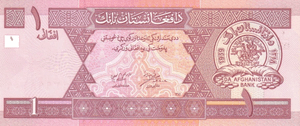 |
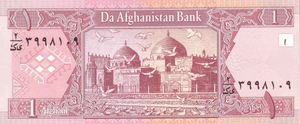 |
1 afghani | 131 × 55 mm | Pink | Seal of Da Afghanistan Bank with Eucratides I-era coin. | Mosque in Mazari Sharif | |
 |
 |
2 afghanis | Blue | Paghman Gardens | |||
 |
 |
5 afghanis | Brown | Bala Hissar | |||
 |
 |
10 afghanis | 136 × 56 mm | Yellow green | Ahmed Shah Durrani mausoleum, Kandahar | Paghman Gardens | |
 |
 |
20 afghanis | 140 × 58 mm | Brown | Mahmud of Ghazni's Tomb | Arg King's Palace | |
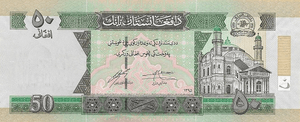 |
 |
50 afghanis | 144 × 60 mm | Dark green | Shah Do Shamira Mosque | Salang Pass | |
 |
 |
100 afghanis | 148 × 62 mm | Violet | Pul e Khishti Mosque | Arch of Bost | |
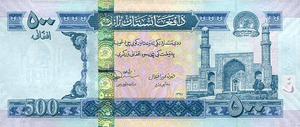 |
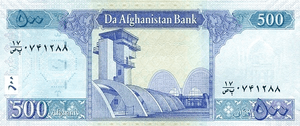 |
500 afghanis | 152 × 64 mm | Blue | Great Mosque of Herat | Kandahar Airport tower | |
 |
 |
1000 afghanis | 156 × 66 mm | Orange | Mazar Sharif Shrine of Ali | Tomb of Ahmad Shah Durrani Baba | |
Exchange rate
The Afghani exchange rate vis-à-vis the U.S. dollar since 1950 has been shown in the following table:
| Afghani exchange rate (LCU in USD)[16] | ||
|---|---|---|
| Date | Free-market exchange rate | Official exchange rate |
| 1950 | 39.0 | |
| 1960 | 40.8 | 17.7 |
| 1970 | 84.8 | 39.9 |
| 1980 | 39.2 | |
| 2003 | 49.0 | 49.0 |
| 2010 | 45.2 | 45.2 |
| 2019 | 75[2] | 75[2] |
| Current AFN exchange rates | |
|---|---|
| From Google Finance: | AUD CAD CHF EUR GBP HKD JPY USD |
| From Yahoo! Finance: | AUD CAD CHF EUR GBP HKD JPY USD |
| From XE.com: | AUD CAD CHF EUR GBP HKD JPY USD |
| From OANDA: | AUD CAD CHF EUR GBP HKD JPY USD |
| From fxtop.com: | AUD CAD CHF EUR GBP HKD JPY USD |
References
- Da Afghanistan Bank. "Capital Notes Issuance and Auction Archived 2013-05-13 at the Wayback Machine." Accessed 26 Feb 2011.
- "Afghani Falls Against Dollar By 3% In A Month". TOLOnews. April 18, 2019. Retrieved 2019-04-18.
- "Coins and Banknotes". Da Afghanistan بللبفصکنکبگبککزنرکمب کبنبککبنبنکنوو. 2019. Retrieved 2019-04-18.
- Schuler, Kurt. "Tables of Modern Monetary History: Asia". Retrieved 2007-08-27.
- Krause, Chester L.; Clifford Mishler (1991). Standard Catalog of World Coins: 1801–1991 (18th ed.). Krause Publications. ISBN 0873411501.
- Fry, Maxwell J. (1976) "A Monetary Approach to Afghanistan's Flexible Exchange Rate", Journal of Money, Credit and Banking, Vol. 8 (2): 219-225
- Fry, Maxwell J. (1974) "The Afghan Economy: Money, Finance, and the Critical Constraints to Economic Development", Brill Publications, Leiden, Holland
- https://www.mediamonitors.net/perspectives/all-change-for-afghan-currency/
- "Chaos in Kabul amid currency rumours". 22 May 2018 – via news.bbc.co.uk.
- "Dollar could be Afghan stopgap". 22 May 2018 – via news.bbc.co.uk.
- "Afghanistan redenominates currency". 4 September 2002 – via news.bbc.co.uk.
- wires, Staff and. "CNN.com - Afghanistan banks on new currency - Oct. 5, 2002". edition.cnn.com.
- "Afghanistan coins". Numista. Retrieved 17 April 2013.
- "Coining Hope In Afghanistan". CBS News. Retrieved 9 November 2017.
- Gebauer, Herbert Daniel. 2004. Resources on the Speleology of Afghanistan. Berliner Hoehlenkundliche Berichte. Band 14. ISSN 1617-8572. Page 81.
- Sources: Fry, Maxwell (1976); and "World Development Indicators" database of the World Bank
Further reading
- Pick, Albert (1994). Standard Catalog of World Paper Money: General Issues. Colin R. Bruce II and Neil Shafer (editors) (7th ed.). Krause Publications. ISBN 0-87341-207-9.
External links
| Wikimedia Commons has media related to Money of Afghanistan. |
- Afghanistan's paper money
- Ancient banknotes of Afghanistan
- Ministry of Finance, Afghanistan
- Afghan Afghani Exchange Rates